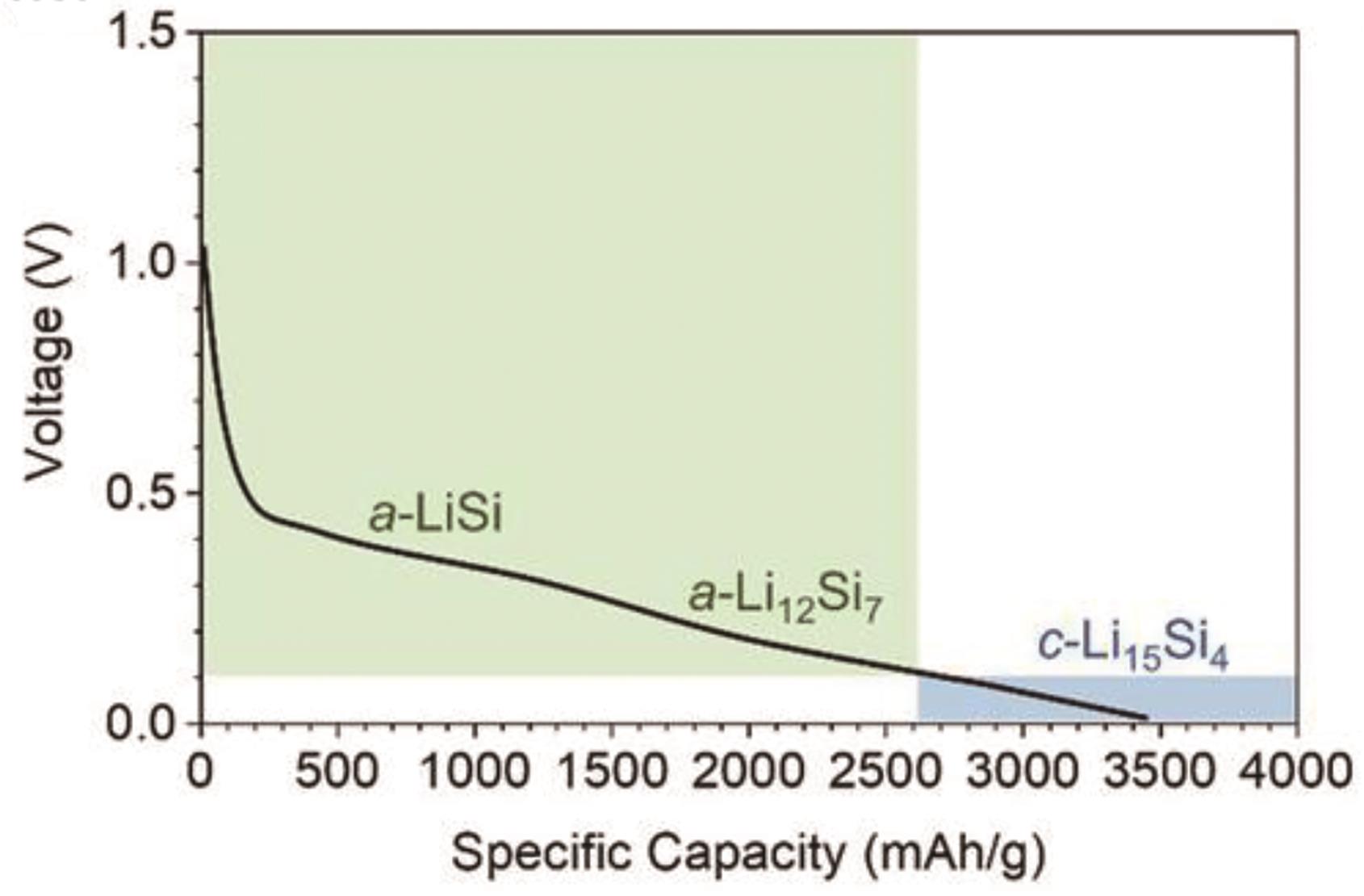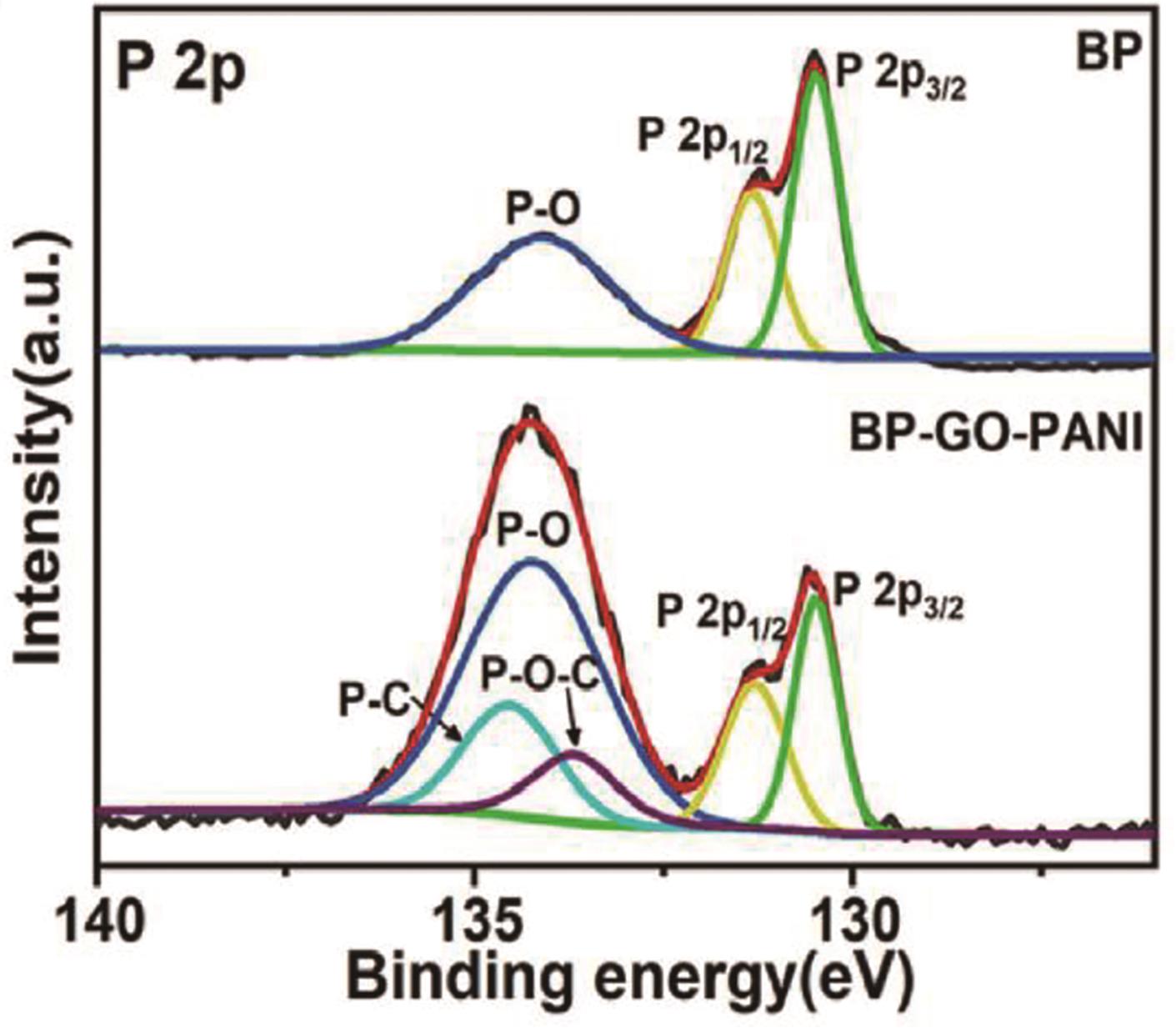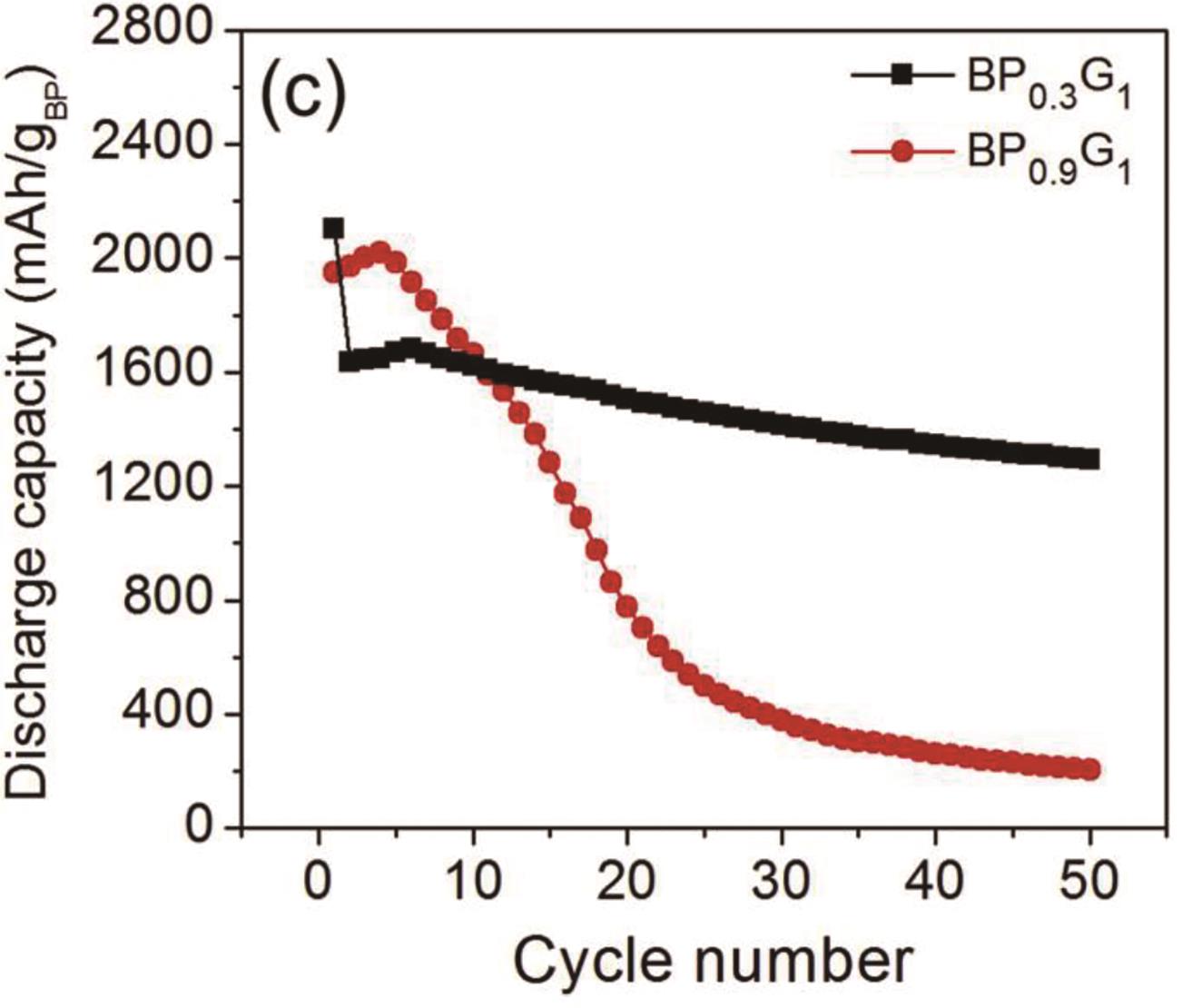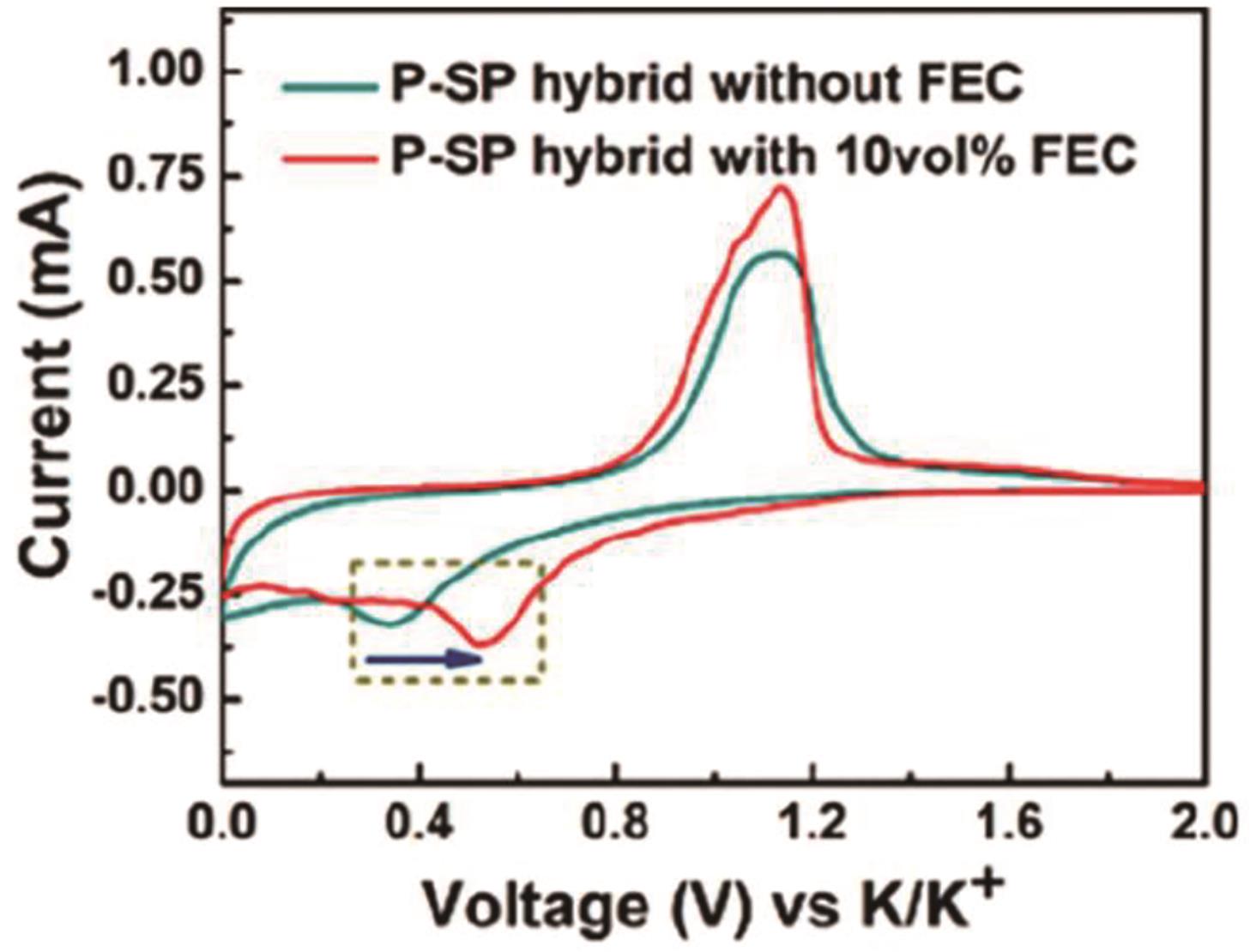
应用化学 ›› 2023, Vol. 40 ›› Issue (4): 571-582.DOI: 10.19894/j.issn.1000-0518.220324
锂离子电池黑磷负极的储能优势及其优化的研究进展
胡方正1, 高兴2, 刘雷1, 袁天恒1, 曹宁1, 李凯1, 王亚涛3, 李建华3, 连慧琴1( ), 汪晓东2, 崔秀国1(
), 汪晓东2, 崔秀国1( )
)
- 1.北京石油化工学院特种弹性体及复合材料北京市重点实验室,北京 102617
2.北京化工大学有机-无机复合材料国家重点实验室,北京 100029
3.开滦煤化工研发中心,唐山 064012
-
收稿日期:2022-10-07接受日期:2023-02-15出版日期:2023-04-01发布日期:2023-04-17 -
通讯作者:连慧琴,崔秀国 -
基金资助:国家自然科学基金(51573021)
Advances in Black Phosphorus Anode Advantages and Optimization in Li-ion Battery Anodes
Fang-Zheng HU1, Xing GAO2, Lei LIU1, Tian-Heng YUAN1, Ning CAO1, Kai LI1, Ya-Tao WANG3, Jian-Hua LI3, Hui-Qin LIAN1( ), Xiao-Dong WANG2, Xiu-Guo CUI1(
), Xiao-Dong WANG2, Xiu-Guo CUI1( )
)
- 1.Beijing Key Laboratory of Special Elastomers,Beijing Institute of Petrochemical Technology,Beijing 102617,China
2.State Key Laboratory of Organic-Inorganic Composites,Beijing University of Chemical Technology,Beijing 100029,China
3.Kailuan R&D Center of Coal Chemical Industry,Tangshan 064012,China
-
Received:2022-10-07Accepted:2023-02-15Published:2023-04-01Online:2023-04-17 -
Contact:Hui-Qin LIAN,Xiu-Guo CUI -
About author:cuixiuguo@bipt.edu.cn; lianhuiqin@bipt.edu.cn
-
Supported by:the National Natural Science Foundation of China(51573021)
摘要:
在减少碳排放实现碳中和的新能源发展背景下,以锂离子电池为代表的动力电池被赋予更高期望,探索开发满足高容量、高倍率和高稳定性的新材料已然成为发展关键。石墨负极和硅碳负极目前发展较为成熟,并保持着各自优势。黑磷作为新型储能材料,依靠自身二维层状结构和较高的锂化电位,展现出在实现超快充电方面的突出优势,但也存在体积膨胀等问题。针对黑磷负极存在的问题,研究者们从各维度进行优化研究,包括结构优化、表界面优化以及预锂化策略。本文首先从各角度综合论证了黑磷可以作为超快充电锂离子电池负极的可能性,进而综述了针对黑磷负极的优化进展,并提出自己的观点和建议,指出黑磷负极面临的挑战和发展方向,展望了黑磷负极的发展前景。
中图分类号:
引用本文
胡方正, 高兴, 刘雷, 袁天恒, 曹宁, 李凯, 王亚涛, 李建华, 连慧琴, 汪晓东, 崔秀国. 锂离子电池黑磷负极的储能优势及其优化的研究进展[J]. 应用化学, 2023, 40(4): 571-582.
Fang-Zheng HU, Xing GAO, Lei LIU, Tian-Heng YUAN, Ning CAO, Kai LI, Ya-Tao WANG, Jian-Hua LI, Hui-Qin LIAN, Xiao-Dong WANG, Xiu-Guo CUI. Advances in Black Phosphorus Anode Advantages and Optimization in Li-ion Battery Anodes[J]. Chinese Journal of Applied Chemistry, 2023, 40(4): 571-582.
使用本文
| Active materials | First cycle reversible specific capacity/(mA·h·g-1) | Initial coulomb efficiency/% | Ampere density/(A·g-1)/number of cycles/capacity retention rate/% | Ref. |
|---|---|---|---|---|
| Graphite | 224 | 99.8 | 4 C/200/98.2 | [ |
| PG-SPS | 1 302 | 60.2 | 10/1 000/33.2 | [ |
| BP-G/PANI | 1 650 | 76 | 13/2 000/26.7 | [ |
表1 超快充电材料及其性能对比
Table 1 Ultrafast charging materials and their performance comparison
| Active materials | First cycle reversible specific capacity/(mA·h·g-1) | Initial coulomb efficiency/% | Ampere density/(A·g-1)/number of cycles/capacity retention rate/% | Ref. |
|---|---|---|---|---|
| Graphite | 224 | 99.8 | 4 C/200/98.2 | [ |
| PG-SPS | 1 302 | 60.2 | 10/1 000/33.2 | [ |
| BP-G/PANI | 1 650 | 76 | 13/2 000/26.7 | [ |
| Active materials | Optimization policy | Initial coulomb efficiency/% | First cycle reversible specific capacity/(mA·h·g-1) | Ampere density/(A·g-1)| | Ref. |
|---|---|---|---|---|---|
| L-BP-S/Super P | BP Nano-crystallization | 40.2 | 441.1 | 1.0/200/91.7 | [ |
| BPQDS/N-graphene | BPQDS | 76.8 | 1 583 | 0.5/100/80.3 | [ |
| BP/G/CNTs | Conductive frame | 73.4 | 1 375 | 2.0/3 000/40.0 | [ |
| BPC | Conductive frame | 90.5 | 2 512.4 | 1.0 C/100/63.4 | [ |
| BP-GO-PANI | Conductive coating | 38 | 884 | 5.0/2 000/108.4 | [ |
| P/CNT-10% LiF | Pre-lithiation | 81 | 1 330 | 0.2/500/58.9 | [ |
表2 不同优化策略下电池的性能对比
Table 2 Comparison of battery performance under different optimization strategies
| Active materials | Optimization policy | Initial coulomb efficiency/% | First cycle reversible specific capacity/(mA·h·g-1) | Ampere density/(A·g-1)| | Ref. |
|---|---|---|---|---|---|
| L-BP-S/Super P | BP Nano-crystallization | 40.2 | 441.1 | 1.0/200/91.7 | [ |
| BPQDS/N-graphene | BPQDS | 76.8 | 1 583 | 0.5/100/80.3 | [ |
| BP/G/CNTs | Conductive frame | 73.4 | 1 375 | 2.0/3 000/40.0 | [ |
| BPC | Conductive frame | 90.5 | 2 512.4 | 1.0 C/100/63.4 | [ |
| BP-GO-PANI | Conductive coating | 38 | 884 | 5.0/2 000/108.4 | [ |
| P/CNT-10% LiF | Pre-lithiation | 81 | 1 330 | 0.2/500/58.9 | [ |
| 1 | SHEKHAR A R, PAREKH M H, POL V G. Worldwide ubiquitous utilization of lithium-ion batteries: what we have done, are doing, and could do safely once they are dead?[J]. J Power Sources, 2022, 523: 231015. |
| 2 | ARSHAD F, LIN J, MANURKAR N, et al. Life cycle assessment of lithium-ion batteries: a critical review[J]. Resour Conserv Recycl, 2022, 180: 106164. |
| 3 | LARCHER D, TARASCON J M. Towards greener and more sustainable batteries for electrical energy storage[J]. Nat Chem, 2015, 7(1): 19-29. |
| 4 | IEA. Net zero by 2050 a roadmap for the global energy sector[J]. IEA, 2021, www.iea.org. |
| 5 | LIN B, LI Z. Towards world's low carbon development: the role of clean energy[J]. Appl Energy, 2022, 307: 118160. |
| 6 | LI H S, GENG Y C, SHINWARI R, et al. Does renewable energy electricity and economic complexity index help to achieve carbon neutrality target of top exporting countries?[J]. J Environ Manage, 2021, 299: 113386. |
| 7 | JUAN L, SHEN Y, LI X, et al. BRICS carbon neutrality target: measuring the impact of electricity production from renewable energy sources and globalization[J]. J Environ Manage, 2021, 298: 113460. |
| 8 | AFSHAR S, MACEDO P, MOHAMED F, et al. Mobile charging stations for electric vehicles-a review[J]. Renew Sust Energy Rev, 2021, 152: 111654. |
| 9 | VERMA S, MISHRA S, GAUR A, et al. A comprehensive review on energy storage in hybrid electric vehicle[J]. J Traffic Transp Eng, 2021, 8(5): 621-637. |
| 10 | LAI X, CHEN Q, TANG X, et al. Critical review of life cycle assessment of lithium-ion batteries for electric vehicles: a lifespan perspective[J]. Etransportation, 2022, 12: 100169. |
| 11 | SPEIRS J, CONTESTABILE M, HOUARI Y, et al. The future of lithium availability for electric vehicle batteries[J]. Renew Sust Energ Rev, 2014, 35: 183-193. |
| 12 | ZENG X, LI M, ABD EL-HADY D, et al. Commercialization of lithium battery technologies for electric vehicles[J]. Adv Energy Mater, 2019, 9(27): 1900161. |
| 13 | CANO Z P, BANHAM D, YE S, et al. Batteries and fuel cells for emerging electric vehicle markets[J]. Nat Energy, 2018, 3(4): 279-289. |
| 14 | NZEREOGU P U, OMAH A D, EZEMA F I, et al. Anode materials for lithium-ion batteries: a review[J]. Appl Surface Sci Adv, 2022, 9: 100233. |
| 15 | QI W, SHAPTER J G, WU Q, et al. Nanostructured anode materials for lithium-ion batteries: principle, recent progress and future perspectives[J]. J Mater Chem A, 2017, 5(37): 19521-19540. |
| 16 | LU Y, YU L, LOU X W. Nanostructured conversion-type anode materials for advanced lithium-ion batteries[J]. Chem, 2018, 4(5): 972-996. |
| 17 | DAI J, LI J, ZHANG Q, et al. Co3S4@C@MoS2 microstructures fabricated from MOF template as advanced lithium-ion battery anode[J]. Mater Lett, 2019, 236: 483-486. |
| 18 | CHEN D, JI G, DING B, et al. Double transition-metal chalcogenide as a high-performance lithium-ion battery anode material[J]. Ind Eng Chem Res, 2014, 53(46): 17901-17908. |
| 19 | YANG Y, YUE Y, WANG L, et al. Facile synthesis of mesoporous TiNb2O7/C microspheres as long-life and high-power anodes for lithium-ion batteries[J]. Int J Hydrogen Energy, 2020, 45(22): 12583-12592. |
| 20 | AGHAMOHAMMADI H, HASSANZADEH N, ESLAMI-FARSANI R. A review study on titanium niobium oxide-based composite anodes for Li-ion batteries: synthesis, structure, and performance[J]. Ceram Int, 2021, 47(19): 26598-26619. |
| 21 | JIANG F, DU R, YAN X, et al. Ferroferric oxide nanoclusters decorated Ti3C2Tx nanosheets as high performance anode materials for lithium ion batteries[J]. Electrochim Acta, 2020, 329: 135146. |
| 22 | CABELLO M, GUCCIARDI E, HERRAN A, et al. Towards a high-power Si@graphite anode for lithium ion batteries through a wet ball milling process[J]. Molecules, 2020, 25(11): 2494-2508. |
| 23 | LV X, WEI W, HUANG B, et al. Achieving high energy density for lithium-ion battery anodes by Si/C nanostructure design[J]. J Mater Chem A, 2019, 7(5): 2165-2171. |
| 24 | WANG X, ZHANG Y, SHI Y, et al. Conducting polyaniline/poly(acrylic acid)/phytic acid multifunctional binders for Si anodes in lithium ion batteries[J]. Ionics, 2019, 25(11): 5323-5331. |
| 25 | LI P, HWANG J Y, SUN Y K. Nano/microstructured silicon-graphite composite anode for high-energy-density Li-ion battery[J]. ACS Nano, 2019, 13(2): 2624-2633. |
| 26 | BRIDGMAN P W. Two new modifications of phosphorus[J]. Dissociation Pressures Halides, Etc, 1914, 238: 344-363. |
| 27 | KHANDELWAL A, MANI K, KARIGERASI M H, et al. Phosphorene-the two-dimensional black phosphorous: properties, synthesis and applications[J]. Mater Sci Eng B-Adv, 2017, 221: 17-34. |
| 28 | FU Y, WEI Q, ZHANG G,et al. Advanced phosphorus-based materials for lithium/sodium-ion batteries: recent developments and future perspectives[J]. Adv Energy Mater, 2018, 8(13): 1702849. |
| 29 | WANG C, ZHANG L, ZHANG Z, et al. Layered materials for supercapacitors and batteries: applications and challenges[J]. Prog Mater Sci, 2021, 118: 100763. |
| 30 | LIU H, ZOU Y, TAO L, et al. Sandwiched thin-film anode of chemically bonded black phosphorus/graphene hybrid for lithium-ion battery[J]. Small, 2017, 13(33): 1700758. |
| 31 | ZHU J, XIAO G, ZUO X. Two-dimensional black phosphorus: an emerging anode material for lithium-ion batteries[J]. Nano-Micro Lett, 2020, 12(1): 120-145. |
| 32 | LATE D J. Liquid exfoliation of black phosphorus nanosheets and its application as humidity sensor[J]. Microporous Mesoporous Mater, 2016, 225: 494-503. |
| 33 | SUN Z, ZHAO Y, LI Z,et al. TiL4-coordinated black phosphorus quantum dots as an efficient contrast agent for in vivo photoacoustic imaging of cancer[J]. Small, 2017, 13(11): 1602896. |
| 34 | JIN H, HUANG Y, WANG C, et al. Phosphorus‐based anodes for fast charging lithium‐ion batteries: challenges and opportunities[J]. Small Sci, 2022, 2(6): 2200015. |
| 35 | SUN Y, WANG L, LI Y, et al. Design of red phosphorus nanostructured electrode for fast-charging lithium-ion batteries with high energy density[J]. Joule, 2019, 3(4): 1080-1093. |
| 36 | PARK M, ZHANG X C, CHUNG M D, et al. A review of conduction phenomena in Li-ion batteries[J]. J Power Sources, 2010, 195(24): 7904-7929. |
| 37 | KIM Y O, PARK S M. Intercalation mechanism of lithium ions into graphite layers studied by nuclear magnetic resonance and impedance experiments[J]. J Electrochem Soc, 2001, 148(3): A194-A199. |
| 38 | BEHESHTI S H, JAVANBAKHT M, OMIDVAR H, et al. Development, retainment, and assessment of the graphite-electrolyte interphase in Li-ion batteries regarding the functionality of SEI-forming additives[J]. iScience, 2022, 25(3): 103862. |
| 39 | SUN S Y, YAO N, JIN C B, et al. The crucial role of electrode potential of a working anode in dictating the structural evolution of solid electrolyte interphase[J]. Angew Chem Int Ed, 2022, 61(42): 8743. |
| 40 | LI L, ZHANG D, DENG J, et al. Carbon-based materials for fast charging lithium-ion batteries[J]. Carbon, 2021, 183: 721-734. |
| 41 | QI W, BEN L, YU H, et al. Improving the electrochemical cycling performance of anode materials via facile in situ surface deposition of a solid electrolyte layer[J]. J Power Sources, 2019, 424: 150-157. |
| 42 | JIANG L L, YAN C, YAO Y X, et al. Inhibiting solvent co-intercalation in a graphite anode by a localized high-concentration electrolyte in fast-charging batteries[J]. Angew Chem Int Ed, 2021, 60(7): 3402-3406. |
| 43 | LI P, KIM H, MYUNG S T, et al. Diverting exploration of silicon anode into practical way: a review focused on silicon-graphite composite for lithium ion batteries[J]. Energy Storage Mater, 2021, 35: 550-576. |
| 44 | SON Y, SIM S, MA H, et al. Exploring critical factors affecting strain distribution in 1D silicon-based nanostructures for lithium-ion battery anodes[J]. Adv Mater, 2018, 30(15): e1705430. |
| 45 | LIMTHONGKUL P, JANG Y I, DUDNEY N J, et al. Electrochemically-driven solid-state amorphization in lithium-metal anodes[J]. J Power Sources, 2003, 119/120/121: 604-609. |
| 46 | MOON J, LEE B, CHO M, et al. Ab initio and kinetic Monte Carlo simulation study of lithiation in crystalline and amorphous silicon[J]. J Power Sources, 2014, 272: 1010-1017. |
| 47 | LIU X H, ZHANG L Q, ZHONG L, et al. Ultrafast electrochemical lithiation of individual Si nanowire anodes[J]. Nano Lett, 2011, 11(6): 2251-2258. |
| 48 | GHASSEMI H, AU M, CHEN N, et al. In situ electrochemical lithiation/delithiation observation of individual amorphous Si nanorods[J]. ACS Nano, 2011, 5(10): 7805-7811. |
| 49 | WANG C M, LI X, WANG Z,et al. In situ TEM investigation of congruent phase transition and structural evolution of nanostructured silicon/carbon anode for lithium ion batteries[J]. Nano Lett, 2012, 12(3): 1624-1632. |
| 50 | GU M, WANG Z, CONNELL J G, et al. Electronic origin for the phase transition from amorphous LixSi to crystalline Li15Si4[J]. ACS Nano, 2013, 7(7): 6303-6309. |
| 51 | WANG Z, GU M, ZHOU Y, et al. Electron-rich driven electrochemical solid-state amorphization in Li-Si alloys[J]. Nano Lett, 2013, 13(9): 4511-4516. |
| 52 | CHEVRIER V L, DAHN H M, DAHN J R. Activation energies of crystallization events in electrochemically lithiated silicon[J]. J Electrochem Soc, 2011, 158: A1207. |
| 53 | CHAE S, CHOI S H, KIM N, et al. Integration of graphite and silicon anodes for the commercialization of high-energy lithium-ion batteries[J]. J Electrochem Soc, 2020, 59(1): 110-135. |
| 54 | CHAN C K, PENG H, LIU G,et al. High-performance lithium battery anodes using silicon nanowires[J]. Nat Nanotechnol, 2008, 3(1): 31-35. |
| 55 | SHENOY V B, JOHARI P, QI Y. Elastic softening of amorphous and crystalline Li-Si phases with increasing Li concentration: a first-principles study[J]. J Power Sources, 2010, 195(19): 6825-6830. |
| 56 | MOON J, CHO K, CHO M. Ab-initio study of silicon and tin as a negative electrode materials for lithium-ion batteries[J]. Int J Precis Eng Man, 2012, 13(7): 1191-1197. |
| 57 | SONG M S, CHANG G, JUNG D W, et al. Strategy for boosting Li-ion current in silicon nanoparticles[J]. ACS Energy Lett, 2018, 3(9): 2252-2258. |
| 58 | SUN L, XIE J, JIN Z. Different dimensional nanostructured silicon materials: from synthesis methodology to application in high‐energy lithium‐ion batteries[J]. Energy Technol, 2019, 7(11): 1900962. |
| 59 | AN Y, TIAN Y, WEI C, et al. Scalable and physical synthesis of 2D silicon from bulk layered alloy for lithium-ion batteries and lithium metal batteries[J]. ACS Nano, 2019, 13(12): 13690-13701. |
| 60 | AN Y, TIAN Y, WEI H,et al. Porosity‐ and graphitization‐controlled fabrication of nanoporous silicon@carbon for lithium storage and its conjugation with MXene for lithium‐metal anode[J]. Adv Funct Mater, 2019, 30(9): 1908721. |
| 61 | GE M, RONG J, FANG X,et al. Porous doped silicon nanowires for lithium ion battery anode with long cycle life[J]. Nano Lett, 2012, 12(5): 2318-2323. |
| 62 | CHAN C K, PENG H, LIU G,et al. High-performance lithium battery anodes using silicon nanowires[J]. Nat Nanotechnol, 2008, 3(1): 31-35. |
| 63 | HEMBRAM K, JUNG H, YEO B C, et al. A comparative first-principles study of the lithiation, sodiation, and magnesiation of black phosphorus for Li-, Na-, and Mg-ion batteries[J]. Phys Chem Chem Phys, 2016, 18(31): 21391-21397. |
| 64 | HEMBRARN K, JUNG H, YEO B C, et al. Unraveling the atomistic sodiation mechanism of black phosphorus for sodium ion batteries by first-principles calculations[J]. J Phys Chem C, 2015, 119(27): 15041-15046. |
| 65 | JIN H, WANG H, QI Z, et al. A black phosphorus-graphite composite anode for Li-/Na-/K-ion batteries[J]. Angew Chem Int Ed, 2020, 59(6): 2318-2322. |
| 66 | JUNG S C, HAN Y K. Thermodynamic and kinetic origins of lithiation-induced amorphous-to-crystalline phase transition of phosphorus[J]. J Phys Chem C, 2015, 119(22): 12130-12137. |
| 67 | ZHANG Y, WANG H, LUO Z, et al. An air-stable densely packed phosphorene-graphene composite toward advanced lithium storage properties[J]. Adv Energy Mater, 2016, 6(12): 1600453. |
| 68 | JIN H, XIN S, CHUANG C, et al. Black phosphorus composites with engineered interfaces for high-rate high-capacity lithium storage[J]. Science, 2020, 370(6513): 192-197. |
| 69 | ZHENG W, LEE J, GAO Z W, et al. Laser-assisted ultrafast exfoliation of black phosphorus in liquid with tunable thickness for Li-ion batteries[J]. Adv Energy Mater, 2020, 10(31): 1903490. |
| 70 | PAN L, ZHU X D, SUNG K N, et al. Molecular level distribution of black phosphorus quantum dots on nitrogen doped graphene nanosheets for superior lithium storage[J]. Nano Energy, 2016, 30: 347-354. |
| 71 | WANG J, LIU W, WANG C. Superior rate and long-lived performance of few-layered black phosphorus-based hybrid anode for lithium-ion batteries[J]. Electrochim Acta, 2022, 403: 228664. |
| 72 | SUN J, ZHENG G, LEE H W,et al. Formation of stable phosphorus-carbon bond for enhanced performance in black phosphorus nanoparticle-graphite composite battery anodes[J]. Nano Lett, 2014, 14(8): 4573-4580. |
| 73 | ZHANG Y, WANG L, XU H,et al. 3D chemical cross‐linking structure of blackphosphorus@CNTs hybrid as a promising anode material for lithium ion batteries[J]. Adv Funct Mater, 2020, 30(12): 1909372. |
| 74 | ZHOU S, LI J, FU L, et al. Black phosphorus/hollow porous carbon for high rate performance lithium-ion battery[J]. ChemElectroChem, 2020, 7(9): 2184-2189. |
| 75 | SHIN H, ZHANG J, LU W. Material structure and chemical bond effect on the electrochemical performance of black phosphorus-graphite composite anodes[J]. Electrochim Acta, 2019, 309: 264-273. |
| 76 | LI M, LI W, HU Y,et al. New insights into the high-performance black phosphorus anode for lithium-ion batteries[J]. Adv Mater, 2021, 33(35): 2101259. |
| 77 | AMINE R, DAALI A, ZHOU X, et al. A practical phosphorus-based anode material for high-energy lithium-ion batteries[J]. Nano Energy, 2020, 74: 104849-104858. |
| 78 | HAN M, ZHANG S, CAO Y, et al. A one-for-all strategy of polyimide coating layer for resolving the comprehensive issues of phosphorus anode[J]. J Energy Chem, 2022, 70: 276-282. |
| 79 | SUN J, LIU C, WANG H, et al. Core-Shell structure of a polypyrrole-coated phosphorus/carbon nanotube anode for high-performance lithium-ion batteries[J]. ACS Appl Energy Mater, 2021, 4(4): 4112-4118. |
| 80 | LI X, HAN X, LIU R, et al. Tannic acid-polypyrrole multifunctional coating layer enhancing the interface effect and efficient Li-ion transport of a phosphorus anode[J]. Nanoscale, 2022, 14(9): 3625-3631. |
| 81 | HAGHIGHAT-SHISHAVAN S, NAZARIAN-SAMANI M, NAZARIAN-SAMANI M, et al. Strong, persistent superficial oxidation-assisted chemical bonding of black phosphorus with multiwall carbon nanotubes for high-capacity ultradurable storage of lithium and sodium[J]. J Mater Chem A, 2018, 6(21): 10121-10134. |
| 82 | ZHAO Y, WANG H, HUANG H, et al. Surface coordination of black phosphorus for robust air and water stability[J]. Angew Chem Int Ed, 2016, 55(16): 5003-5007. |
| 83 | JIA C, ZHAO L, CUI M, et al. Surface coordination modification and electrical properties of few-layer black phosphorus exfoliated by the liquid-phase method[J]. J Alloys Compd, 2019, 799: 99-107. |
| 84 | YI Y, YU X F, ZHOU W, et al. Two-dimensional black phosphorus: synthesis, modification, properties, and applications[J]. Mater Sci Eng, 2017, 120: 1-33. |
| 85 | YANG B, WAN B, ZHOU Q, et al. Te-doped black phosphorus field-effect transistors[J]. Adv Mater, 2016, 28(42): 201603723. |
| 86 | GUO Z, CHEN S, WANG Z, et al. Metal-ion-modified black phosphorus with enhanced stability and transistor performance[J]. Adv Mater, 2017, 29(42): 1703811. |
| 87 | DOGANOV R A, O'FARRELL E C T, KOENIG S P, et al. Transport properties of pristine few-layer black phosphorus by van der Waals passivation in an inert atmosphere[J]. Nat Commun, 2015, 6: 7647-7654. |
| 88 | RYDER C R, WOOD J D, WELLS S A, et al. Covalent functionalization and passivation of exfoliated black phosphorus via aryl diazonium chemistry[J]. Nat Chem, 2016, 8(6): 597-602. |
| 89 | ABELLAN G, LLORET V, MUNDLOCH U, et al. Noncovalent functionalization of black phosphorus[J]. Angew Chem Int Ed, 2016, 55(47): 14557-14562. |
| 90 | TOFAN D, SAKAZAKI Y, MITRA K L W, et al. Surface modification of black phosphorus with group 13 lewis acids for ambient protection and electronic tuning[J]. Angew Chem Int Ed, 2021, 60(15): 8329-8336. |
| 91 | VAN DRUENEN M, DAVITT F, COLLINS T, et al. Covalent functionalization of few-layer black phosphorus using iodonium salts and comparison to diazonium modified black phosphorus[J]. Chem Mater, 2018, 30(14): 4667-4674. |
| 92 | HAN X, SUN J. Improved fast-charging performances of phosphorus electrodes using the intrinsically flame-retardant LiFSI based electrolyte[J]. J Power Sources, 2020, 474: 228664. |
| 93 | YUAN S, WENG S, WANG F,et al. Revisiting the designing criteria of advanced solid electrolyte interphase on lithium metal anode under practical condition[J]. Nano Energy, 2021, 83: 105847. |
| 94 | LEI W, LIU Y, JIAO X,et al. Improvement of cycling phosphorus-based anode with LiF-rich solid electrolyte interphase for reversible lithium storage[J]. ACS Appl Energy Mater, 2019, 2(4): 2699-2707. |
| 95 | LIU C, HAN M, CAO Y,et al. Unlocking the dissolution mechanism of phosphorus anode for lithium-ion batteries[J]. Energy Storage Mater, 2021, 37: 417-423. |
| 96 | JARVIS C R, LAIN M J, YAKOVLEVA M V, et al. A prelithiated carbon anode for lithium-ion battery applications[J]. J Power Sources, 2006, 162(2): 800-802. |
| 97 | WANG Z H, FU Y B, ZHANG Z C, et al. Application of Stabilized Lithium Metal Powder (SLMP (R)) in graphite anode-a high efficient prelithiation method for lithium-ion batteries[J]. J Power Sources, 2014, 260: 57-61. |
| 98 | HUANG Z, DENG Z, ZHONG Y, et al. Progress and challenges of prelithiation technology for lithium-ion battery[J]. Carbon Energy, 2022, 4: 1107-1132. |
| [1] | 陈兵帅, 卓海涛, 黄书, 陈少军. 高性能硅基负极聚合物粘结剂的研究进展[J]. 应用化学, 2023, 40(5): 625-639. |
| [2] | 石雪建, 刘万强, 王春丽, 程勇, 王立民. 钾离子电池用Sb基负极材料研究进展[J]. 应用化学, 2023, 40(2): 210-228. |
| [3] | 王恩通, 杨林芳. 高比容量锂离子电池正极材料LiNi0.6Co0.2Mn0.2O2的制备及性能[J]. 应用化学, 2022, 39(8): 1209-1215. |
| [4] | 王福洋, 宋伟明, 孙立, 冯建, 叶军, 杨芷奇. 多孔纳米立方FeSe2/石墨烯复合材料的可控构建及在钠离子电池中的应用[J]. 应用化学, 2022, 39(5): 779-786. |
| [5] | 宋林虎, 李世友, 王洁, 张晶晶, 张宁霜, 赵冬妮, 徐菲. 锂离子电池电解液除酸除水添加剂的研究进展[J]. 应用化学, 2022, 39(5): 697-706. |
| [6] | 张琦, 张乾, 师晓梦, 孔娅淇, 高可心, 杜亚平. 稀土溴化物固态电解质材料在全固态电池中的应用研究进展[J]. 应用化学, 2022, 39(4): 585-598. |
| [7] | 王玉乐, 杨柯利, 高艳芳. 碳化钼改性二氧化硅的制备及其电化学性能[J]. 应用化学, 2022, 39(11): 1716-1725. |
| [8] | 赵莹, 邵奕嘉, 李罗钱, 任建伟, 廖世军. 富锂正极材料的衰减机理及循环稳定性提升的研究进展[J]. 应用化学, 2022, 39(02): 205-222. |
| [9] | 王旭尧, 方应军, 张灵志. 氰基功能化聚乙烯亚胺交联固态聚合物电解质的制备及理化性能[J]. 应用化学, 2021, 38(8): 946-953. |
| [10] | 陶承业, 杨占旭, 李玥. 红磷/石墨复合材料的制备及电化学性能[J]. 应用化学, 2020, 37(9): 1056-1061. |
| [11] | 刘学, 马华, 徐恒, 计海聪, 王栋. 无纺布基聚吡咯柔性电极的储锂性能[J]. 应用化学, 2020, 37(5): 555-561. |
| [12] | 王金莹, 曲江英, 李杰兰, 汤占磊, 臧云浩, 王涛, 顾建峰, 周钢, 高峰. 二次包覆法制备煤沥青基硅/碳复合物及其锂离子电池性能[J]. 应用化学, 2020, 37(5): 562-569. |
| [13] | 胡晨,金翼,朱少青,徐晔,水江澜. 磷酸铁锂电池低温性能的改性方法简述[J]. 应用化学, 2020, 37(4): 380-386. |
| [14] | 崔华敏, 掌学谦, 胡攀登, 闫冰, 黄苇苇, 郭文锋. 杯[4]醌/N掺杂的无定形碳纳米纤维复合材料储锂性能[J]. 应用化学, 2020, 37(2): 198-204. |
| [15] | 惠康龙, 傅继澎, 高湉, 唐明学. 金属硫化物在可充电电池中的研究进展[J]. 应用化学, 2020, 37(12): 1384-1402. |
| 阅读次数 | ||||||||||||||||||||||||||||||||||||||||||||||||||
|
全文 3676
|
|
|||||||||||||||||||||||||||||||||||||||||||||||||
|
摘要 1012
|
|
|||||||||||||||||||||||||||||||||||||||||||||||||






